
MAY CONTAIN NUTS

Search Shorpy
SHORPY ART

Framed or unframed, desk size to sofa size, printed by us in Arizona and Alabama since 2007. Explore now.
Join and Share
Ad-Free Shorpy
Shorpy is funded by you. Patreon contributors get an ad-free experience.
Learn more.

Recent comments
- Recent view
- Hudson’s Big Store
- Say what??
- Grapes?!
- A Beautiful Moment
- Such joy
- Bethune-Cookman University today...
- Yellow sky at morning
- Side Winder
- Air Quality?
- Sojourner Truth riot
- None were so blind(ed)
- The less famous sister
- Good ol' days?
- Rise and Fall
- Goo Goo Ga Joob
- Ticket Retention
- Not the only one
- Vagaries of War
- Killed by Amtrak
- Back to the Future
- Wanted --
- If you can't stand the light
- Centralized Traffic Control, I believe
- What's really happening
- Heckuva remote control!
- Sometimes — Things Go Bump!
- I SEE THE LIGHT
- Union Switch and Signal Company
- Get That Light Out Of My Eyes
Member Photos
The Shorpy
Print Emporium
Print Emporium
Search Shorpy
Search results -- 30 results per page
- The Invisible Ray: 1921
- ... how the hero escaped death.
I hope we get to see the interior of the Leader Theater.
High Voltage Check out the special f/x ... Posted by Dave - 09/03/2012 - 11:57am -
![The Invisible Ray: 1921 Washington's Leader Theater circa 1921. Now playing: The serial "Invisible Ray" and, from 1916, Douglas Fairbanks in "The Americano" and a short called "The Return of Draw Egan." National Photo Company glass negative. View full size.
Saturday morningsMy brothers and I also spent Saturday mornings at the kiddie shows and only as an adult did I figure out exactly what my parents were doing at home while we were at the movies.
At the MoviesReturn with us now to those thrilling days of yesteryear.
-- Introduction to "The Lone Ranger"
When I was a child in the late 1940s, my grandparents took me to the movies every Saturday evening. The theater always showed a double-feature Western, or shoot-'em-up, as my grandfather called them, a cartoon, a short subject like the Three Stooges, and a serial episode. The serials were a clever way to ensure a returning audience for about 12-15 weeks. Each episode always had a cliffhanger ending that made you eager to return next week to learn how the hero escaped death.
I hope we get to see the interior of the Leader Theater.
High VoltageCheck out the special f/x they put up for the "Invisible Ray" display. That makeshift towers on either side look like they have wires strung from insulators, which probably had high voltage running through them to create a Jacob's Ladder type spark gap. There appears to be a spark above the wires, but it looks more like a scratch on the negative, plus the sparks would be jumping between the wires. Although that really wouldn't be invisible or a ray. If only they'd spent as much on an artist for those cutouts.
Asian kid in lineOdd to see an Asian kid in the line. I wonder what the story is?
[Lots of Asian diplomats living with their families in D.C. - Dave]
Asian kidD.C. had a small Chinatown. The kid may have come from there.
Doctored picture?Is it just me or are more then half of those in the "Line" not to right size or porportion. A few almost look like they were cut out of other pics and added in via computer.... Sorry but as a fan of this site and of these pictures I am going to have to put this one under suspicsion. Looking back I think only 13 of those in the line were actully "There" when this picture was taken.
Yes, I do know about old cameras and film.
[Maybe it's time for a refresher course. See where it says "glass negative" in the caption? That means the photo (click here) was made without film. - Dave]
Huh?It looks like a group of people standing outside a theater to me. I can't find one that I think looks not to right size or proportion.
(The Gallery, D.C., Movies, Natl Photo)](https://www.shorpy.com/files/images/30059u.thumbnail.jpg)
- Common Core: 1922
- ... Washington, D.C., circa 1922. "Miss Tomlin's School, interior." Our third visit to the premises of this educational establishment, ... Posted by Dave - 01/05/2015 - 4:41pm -
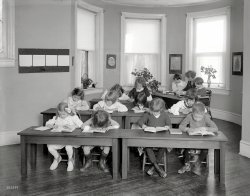
- Rubberneck Auto: 1911
- ... on Ionic columns, attains a total height of 150 feet. The interior is arranged similarly to the tomb of Napoleon at the Hotel des ... Posted by Dave - 08/01/2012 - 5:48pm -
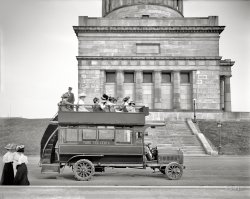
- Overstuffed: 1925
- "O.J. DeMoll, interior." The DeMoll furniture store at 12th and G streets N.W. in Washington ... Posted by Dave - 09/12/2011 - 2:38pm -
![Overstuffed: 1925 "O.J. DeMoll, interior." The DeMoll furniture store at 12th and G streets N.W. in Washington circa 1925. National Photo Company glass negative. View full size.
HorsehairI just can't imagine that old sofa smelling anything other than musty. I wonder what they were like new with tags.
Wow.The only thing I like in this photo are maybe the shop lights. Or the ferns. I can see why the simplicity of the Arts & Crafts movement caught on!
Already PasseCraftsman style furniture was already going out of fashion by the time this furniture was made, and mass-produced Colonial and other revival styles of furniture like these examples had remained more popular in most homes right through the 1895-1920 heyday of Craftsman styles. The upholstered furniture, tables and mirrors in this photo are not all that different than many offered for sale today. The fussy bridge and table lamp shades are the most dated pieces in the showroom. But just when you thought it was safe to go back into the parlor, many lamp dealers are now offering expensive hand-made recreations of these "vintage" shades, and they're selling well.
[I don't know if I'd call this Craftsman. The pieces in this photo are of the Moorish/Mediterranean style in vogue at the time. - Dave]
Top-drawer ceilingThere's a wonderful optical illusion created by the ceiling tiles. Another grand "snapshot" of the past. Many thanks!
Who left.. their iPod on the sofa?
TaggedToo bad we can't read the tags. We are so used to seeing this type of furniture used and worn-in--hard to imagine it new!
[Below, some DeMoll prices from the winter of 1925-26. The davenport in the photo and two chairs went for $150. - Dave]
O.J. DeMollI wonder which corner of 12th and G this is. As I understand it, De Moll first built this showroom on the SW corner in 1909...
... but the piano business expanded so quickly, he moved to a new and larger building on the NW corner in 1913:
Maybe the original piano showroom was converted into a furniture shop? The windows here look more like the 1913 building.
[Our photo is the building on the northwest corner. - Dave]
Ghost or Mortal?Look at the man to the far left behind the open glass door. His head and shoulders appear above the dark lamp shade. His left shoulder blocks the light coming in from the window, but is that the frame I see on the wall behind him? You can see through him!
[The frame is in front of him -- a reflection off the glass door of a mirror across the room. - Dave]
(The Gallery, D.C., Natl Photo, Stores & Markets)](https://www.shorpy.com/files/images/32599u.thumbnail.jpg)
- Roughing It: 1905
- New Zealand circa 1905. "Sumner, Christchurch. Interior of large tent decorated with posters and picture postcards, with ... Posted by Dave - 07/12/2014 - 2:47pm -
![Roughing It: 1905 New Zealand circa 1905. "Sumner, Christchurch. Interior of large tent decorated with posters and picture postcards, with tallboy and mirror, trunks with flags, lamps and 'Myrtle Camp' sign." For the men of Myrtle Camp, all the comforts of home and then some. Glass plate by Adam Maclay. View full size.
Faith BasedAfter seeing the posted signs in this tent, I would say that this might have been either an Evangelical meeting place or a religious retreat.
[One of the pinup-friendly denominations? -Dave]
Or maybe they lapsed.
My God Shall Supply All My NeedsAnd if that's not enough, there's always the Victorian pinups hung up everywhere.
Pretty racy stuffArmless statue porn.
The pinup on the far rightHanging from the dark part of the tent roof. Would be an interesting blowup.
GlampingToday we call this 'glamping'. I guess luxury camping isn't so new after all.
Not a tallboyThat's a lowboy with a mirror, not a tallboy.
(Adam Maclay, Camping, New Zealand)](https://www.shorpy.com/files/images/SHORPY_FL10684284.thumbnail.jpg)
- Message Received: 1943
- ... paper continued far into the diesel locomotive era. Bright interior lighting is not wanted in any locomotive cab - it cuts the crew's ... Posted by Dave - 06/06/2015 - 1:10pm -
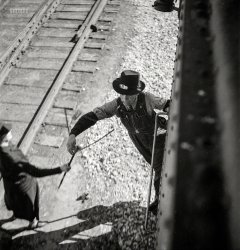
- The Grill Room: 1912
- ... was previously seen in this exterior shot.
The interior picture could have been taken this morning. As strange as every ... Posted by Dave - 08/08/2012 - 7:12pm -
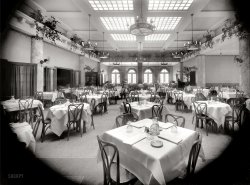
- Lulu Belle: 1959
- ... Sedan Can't really tell without seeing more of the interior, but it is either a Super Holiday or a Holiday Sedan, definitely 1956. ... Posted by Dave - 05/18/2016 - 7:11pm -
![Lulu Belle: 1959 From circa 1959 Scottsdale, Arizona, we bring you this Kodachrome slide of the Lulu Belle restaurant on Main Street. Which seems to have been a combination platter of Old West, Gay Nineties and riverboat themes. View full size.
Building still thereLocated near the corner of Scottsdale Road and Main Street, it's in the heart of touristy downtown Scottsdale.
Nifty carI hope someone can identify the car whose roofline is shown in the foreground of this cool photo. I initially thought it might be a Continental Mark II, but now I think I was wrong.
[Looks like a first generation Ford Thunderbird. -tterrace]
[With some kind of modified roof. - Dave]
Thanks, tterrace and Dave (and the others who commented); it hadn't occurred to me that might be a modified roof on the T-Bird. It looks excellent. We who grew up in the '50s and '60s were lucky to have two things in particular: Great cars and great music!
That roofThe modified removable hardtop on the T-Bird very likely has a '58 Impala fake roof vent added, faired in almost exactly as it was on the Impala. That little chrome grill was an immediate hit with customizers of the period, just like the hood scoop from the T Birds and '59 Cadillac taillights.
56 OldsCan't figure out the roof of the Ford. Cream colored car on left looks like a 56 Olds 88.
CarsWild guesses: 56 Olds Holiday, 57 T Bird, 57 Plymouth Fury, 59 Pontiac Catalina.
Bill of FareI wish I could read the actual menu to see what Wild West / Gay 90s fare was like. I suspect it was a lot like 1950s middle American fare.
1958 Impala Roof ScoopThis is likely a roof scoop from a 1958 Impala. A favorite customizing trick from my perusal of the car magazines in my misspent youth.
Holiday SedanCan't really tell without seeing more of the interior, but it is either a Super Holiday or a Holiday Sedan, definitely 1956. Color could be Alcan White, which was a standard color, or Antique White, which was an option on all 1956 models. Holiday Sedans came with Ivory Moroccan bolsters and a speckled cloth upholstery, while Super Holidays had Ivory leather bolsters and a sort of basketweave upholstery.
Those are accessory wheel covers, and dual exhaust, too.
(The Gallery, Kodachromes, Cars, Trucks, Buses, Eateries & Bars, Found Photos)](https://www.shorpy.com/files/images/SHORPY-IMGX002.thumbnail.jpg)
- Bonbon Noir: 1949
- ... caught my eye are the small showcards at the bottom of the interior window display placed among the candy. In large cities, small signs ... Posted by Dave - 05/27/2021 - 12:04pm -
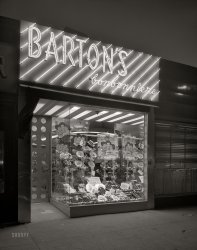
- Shoe City: 1920
- "Hahn's Coliseum, interior." A flag-bedecked footwear sale held by the Hahn's chain of shoe ... Posted by Dave - 02/04/2014 - 9:59am -
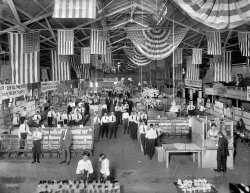
- A Tale of Two Charlies: 1925
- ... and for the next decade worked for the Agriculture and Interior Departments.
(The Gallery, D.C., Natl Photo, Portraits) ... Posted by Dave - 09/12/2011 - 7:22pm -
![A Tale of Two Charlies: 1925 Washington, D.C., 1925. "Charles Widmayer, Margaret Monk and Charles Smoot." National Photo Company Collection glass negative. View full size.
ObitN.Y. Times, Sept. 22, 1991
Charles Edward Widmayer, a founder of Editorial Projects for Education, which published the weekly Chronicle of Higher Education, and for 30 years the editor of the Dartmouth College Alumni Magazine, died Thursday at Alice Peck Day Memorial Hospital in Lebanon, N.H. He was 83 years old. He died from acute respiratory failure, the family said.
Mr. Widmayer, a native of Washington, graduated cum laude from Dartmouth in 1930. After a year's graduate study at Harvard, he returned to Dartmouth and Hanover, N.H., where he lived for the rest of his life. He taught English at Dartmouth in 1932-33 and served as director of athletic publicity in 1933-1934. He joined the staff of the Dartmouth Alumni magazine in 1933. In 1957, he became a founding member of Editorial Projects.
Surviving are his wife, Alene G. Potter Widmayer, to whom he had been married for 53 years, and two sons, Frederick P. and Martin G. Widmayer.
Her PrinceMargaret is quite attractive, given the lack of modern makeup, and seems to be wearing a sort of knowing smirk. Mr. Smoot is rather dashing in a wealthy sort of way. But Margaret is leaning toward Mr. Widmayer, isn't she. Hmmmm.
I agreewith Nate. There is definitely some body language going on there. Besides Mr. Smoot got really carried away with the Pomade in his hair.
That Privileged LookCharles Smoot has all the grooming and the patrician features of a young Joe Kennedy, older brother and once Presidential hopeful of brother John Kennedy.
Central High StudentsThese three were all Central High students when pictured here. I have yet to find the common thread that links them all.
[As in aside, my first association with the name Smoot is not the Smoot-Hawley act (a.k.a. Hoot-Smalley) but rather the non-standard unit of measure for the length of the Harvard Bridge connecting Cambridge to Boston: 364.4 Smoots. One Smoot equating to 67 inches.]
Washington Post, Nov 15, 1925
Central Quill Clique Opens Year's Meetings
The first meeting of the Quill Clique, Central's honorary publications society, was held recently at the home of Miss Alla Rogers, last year's editor of the review. This year's officers are Charles E. Widmayer, president; Miss Elizabeth Howard Wright, vice president; J. Canfield Marsh, recording secretary; Miss Margaret Moreland, corresponding secretary, and Charles Smoot, treasurer.
Is he in the other Smoot picture?Charlie Smoot looks like the little boy in the shot called "Meet the Smoots." I suspect he's the youngest child, on the far right.
[He's a bit young to be the boy in the 1910 photo. Charlie was a student (and cheerleader) at Central High when this photo was made in 1925. Senator Smoot, whose sons were Harold, Harlowe and Ernest (probably the boy in the sailor suit), did have a grandson named Charles, born around 1917. - Dave]
Oh, she is cute.But I'll tell you what: It may be stylish and trendy, but that hairstyle does not work with that shape of face.I'm reminded of the stylist who invented the Jennifer Aniston hairstyle and who was politely furious at its fame; she said people were wearing it who just plain shouldn't.
364.4 smootsThe smoot is a unit of measure at MIT, tracing back to a 1958 fraternity prank whereby one Oliver Smoot was repeatedly laid down on a bridge to measure its length.
Bill Maher '25Charlie on the left is a dead ringer.
Bona dragThey all look very nicely dressed and elegant, the 20s were really a high point in fashion, very timeless. What they are wearing wouldn't look too much out of place even today. Also, the young men's suits are really nicely tailored, and the young woman is elegant without being gaudy.
Charles E. Smoot 1908-1999The Washington Post - Oct 1, 1999
Charles Effinger Smoot, 91, a former assistant general counsel of the Federal Communications Commission and co-founder of the Ski Club of Washington, D.C., died Sept. 23 at Suburban Hospital in Bethesda of respiratory failure.
Born in Staunton, Va., Mr. Smoot moved to the District in 1917 and lived in Washington until shortly before his death. He graduated from Central High School in 1926 and for the next decade worked for the Agriculture and Interior Departments.
(The Gallery, D.C., Natl Photo, Portraits)](https://www.shorpy.com/files/images/13641u.thumbnail.jpg)
- Rust Belt Riviera: 1941
- ... Wonder Boys and Kingpin. You can see the exterior and interior in this clip: https://youtu.be/gO0VwzCuuBM
Update:
Beaver ... Posted by Dave - 11/06/2019 - 1:36pm -
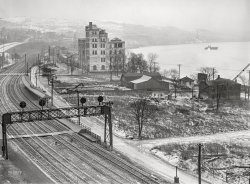
- Model Citizens: 1924
- ... 1906. His father served as an Assistant Secretary of the Interior under President Theodore Roosevelt. He attended Roosevelt High School ... Posted by Dave - 09/03/2012 - 10:42am -
![Model Citizens: 1924 August 12, 1924. "International Boys Leagues. Thomas W. Miles and Simon Zebrock of Los Angeles at White House." View full size. National Photo Co.
Tom and SimonAccording to my research, Thomas W. Miles was born in West Virginia in 1907, and died in Washington, DC, on April 9, 1997. Simon Zebrock (official records indicate spelled Zebrack) was born in Missouri in 1908, and was killed in WWII in 1943.
The UndergraduateAmazing how much the fellow on the right looks like a young Dustin Hoffman!
Tom and SimonThis is Joe Manning again. Further research seems to indicate that the Thomas W. Miles who died in Washington, DC is not the same as the one in the photo. In addition, I just discovered that the Thomas Miles I originally tracked down in the census in Los Angeles, born in 1907, turns out to be white, and the Thomas in the photo appears to be African-American. So it looks like I got this one wrong. I'll work on this some more.
Tom's ShoesI like Thomas's shoes very much, wonder what they are called.
Thomas W. MylesAccording to my research (including numerous articles in the Los Angeles Times digital archives), Thomas William Myles Jr. (not Miles) was born in 1906. His father served as an Assistant Secretary of the Interior under President Theodore Roosevelt. He attended Roosevelt High School in Los Angeles. He became a lawyer and married Dorothy (maiden name unknown) in 1929. When he was 18, he traveled to Paris for a convention of the International Boys League and was elected the organization’s president. He was also president of the California chapter of the junior branch of the NAACP. He was an active advocate for civil rights for African-Americans, and ran for the California State Senate in 1938. He died in Los Angeles on May 2, 1985. I could not locate an obituary, and do not know if he had any children.
TomHe could be wearing spats over regular shoes---I think that was still fairly common in the '20s. Not so easy to find now, but you sometimes can find them through theatrical costume suppliers.
I really like the shine on the shoes!Looks like those fellows knew how to do a good spitshine. Did they have patent leather in '26?
[More than they do today. - Dave]
FatherI was wondering if that was a picture of my Father, Thomas Myles born in 1906 attended Roosevelt High and was a lawer
(The Gallery, D.C., Natl Photo)](https://www.shorpy.com/files/images/26019u.thumbnail.jpg)
- Tourist Auto Co.: 1910
- ... in and out of them. It looks like a long step from the interior to the running board and then again from there to the street.( I ... Posted by Dave - 08/21/2012 - 12:00pm -
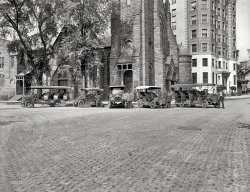
- Beer Boulevard: 1938
- ... long history is was a house of ill repute and the entire interior had been painted pink. The closing of the mill was hard for everyone ... Posted by Dave - 11/26/2017 - 12:49pm -
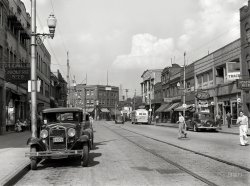
- Washington Shopped Here: 1913
- And Lincoln, too. Interior of the Apolonia Stuntz toy store on New York Avenue, seen from the ... Posted by Dave - 09/12/2011 - 12:26pm -
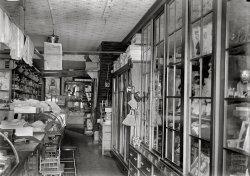
- New England Fish Inc.: 1904
- ... tenders stacked up like that before on both schooners. No interior obstructions whatsoever.
Add: Thanks chicagobob! Cool info
... Posted by Dave - 06/29/2014 - 12:57pm -
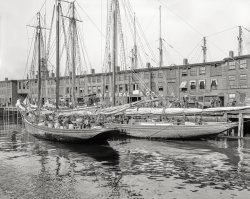
- Fort Sumter: 1865
- 1865. "Charleston, South Carolina. Interior of Fort Sumter, with gabion reinforcements. Photograph of the Federal ... Posted by Dave - 07/31/2012 - 8:41pm -
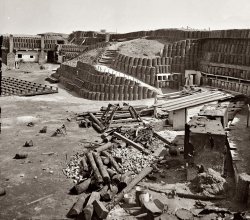
- Sic Transit: 1910
- ... either by train, or horse and wagon. That goes for the interior too.
No snakes But plenty of ladders.
The Pit Does ... Posted by Dave - 11/08/2019 - 10:44am -
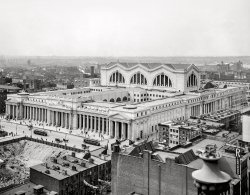
- The Good Life: 1960
- ... fresh out of his tan convertible with the red leather interior, wearing pegged and cuffed khaki trousers with penny loafers and ... Posted by Dave - 11/29/2008 - 6:42pm -
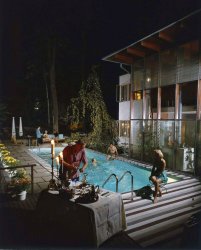
- Irving Place: 1905
- ... by Elsie de Wolfe, the influential and very social interior designer, and her partner Elisabeth Marbury, a successful literary ... Posted by Dave - 08/21/2012 - 12:38pm -
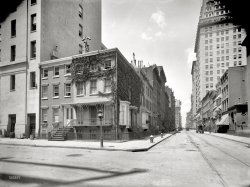
- The Secretary: 1920
- ... She's... inside... so she must be the Secretary of the Interior.
Wonderful Concept That's a remarkably different composition ... Posted by Dave - 08/21/2012 - 7:52pm -
![The Secretary: 1920 Washington, D.C., circa 1920. "National Personnel Service Bureau." This could be a shot composed by Edward Hopper. National Photo Co. View full size.
Have a seatin one of the cane chairs in the foreground. This style chair is a great set item for time-period theatre productions. Hard to find used in a usable state, though.
Name changeAnd today, of course, it would be known as "National Human Resources Service Bureau." Never use one word when two will do.
Let's see if I have this straightShe's... inside... so she must be the Secretary of the Interior.
Wonderful ConceptThat's a remarkably different composition and concept for its time. And it was a two-person shoot: one squeezing the shutter bulb, another firing a very sizable load of flash powder for light which matched the people strongly enough to equal the outdoor exposure. A very talented shooter made this one.
[The photographers employed by the National Photo Co. were, by definition, pros. - tterrace]
Not a typo to be seen What a pleased and composed expression on her lovely, and older, face. An accomplished professional at one with her work. Let's see, perfect margins, no misspelled words, no strikeovers. Her boss is lucky to have her. Wonder what he paid her.
Hide the typewriterBig in those days were desks which actually hide the typewriter when not needed. Some had a pull-up-and cover-it desk top. But I believe this one has the typewriter bolted down and hinge is used to rotate the machine under, leaving a very nice wooden workspace for the secretary to use.
DictionaryShe needed the dictionary in case her spell-check was on the blitz.
[And then there are those beyond the help of spell-check. - Dave]
(The Gallery, D.C., Natl Photo, The Office)](https://www.shorpy.com/files/images/SHORPY_29431u.thumbnail.jpg)
- Re-THINK: 1956
- ... perfect condition 57 Chevy with continental kit and RED interior driving South on Highway 101. Could've pulled right out of this lot, ... Posted by Dave - 07/14/2013 - 11:12pm -
![Re-THINK: 1956 1956. "IBM Manufacturing and Administrative Center, Rochester, Minn. Eero Saarinen, architect." Another perspective on the desk seen here, now with a view of the parking lot. Kodachrome by Balthazar Korab. View full size.
Cigarettes help you thinkYou can see this wasn't taken while the programmers were there. You can see across the room. Back in these days all the programmers smoked like chimneys. You could spot their work area by the cloud of smoke over it.
American Iron outside...Yesterday I saw an all black, perfect condition 57 Chevy with continental kit and RED interior driving South on Highway 101. Could've pulled right out of this lot, given the one year time slip.
I love the lighting, it's like late in the day and most have gone home. Or is it early, and the view the first person in the department gets when they walk in?
It still blows my mind that they needed an architect to build this rectangular room devoid of any personality at all! Is there a defined style called Cookie-Cutter architecture?
Where's my Taurus?Very disconcerting to my mind to see "antiques" out the windows and "modern" furniture inside the windows.
This furniture, and cubicles in the previous pic, are almost identical to much of the furniture at US Steel Gary Works where I toiled in an office much like this one through 1999.
When I look out the window at IBM, I can't help but expect to see 1990's autos! Very cool picture for that reason.
The DeskI don't think it's the exact same desk. The room is completely different. My guess is it's just one of many identical desks and placards that IBM probably bought for that facility.
[Same desk, unless IBM had strict accouterment placement standards. -tterrace]
And not onedrab silver/grey car among those Easter egg colors!
FHS '89Change the cars and remove the ashtrays and that looks like a room in my high school in the '80s!
Deja vuBut for a brief moment just looking at this photo took my mind back in time and there I was sitting on one of those chairs similar to the ones used in our high school cafeteria. And I was gazing through the window, much like the one pictured, at the student parking lot across the street from the cafeteria. Students back in the 60's generally drove cars that were at least 10 years old and it was those cars shown in the photo that took up occupancy in that student parking lot so many years ago.
THINK, the musicalFrom "Songs of the I.B.M." (1937 edition), the words to "Our President's Motto - 'THINK'" (sung to the tune of "Yankee Doodle"):
(verse 1)
T-H-I-N-K spells THINK-
Our President's great motto.
Saves mistakes, lost time and ink.
You'll then do what you ought to.
(verse 2)
T-H-I-N-K spells THINK-
'Tis good for brain and body,
Dark blue visions change to pink.
And you'll please everybody.
(Chorus)
T-H-I-N-K spells THINK-
Thoughts are pure and golden;
Bigger thoughts and good ones too,
Then I.B.M. will broaden.
(Balthazar Korab, Cars, Trucks, Buses, The Office)](https://www.shorpy.com/files/images/SHORPY_00517u.thumbnail.jpg)
- Model 47: 1928
- ... Affairs Regional Office and Insurance Center. By then the interior of the original sawtooth roof had been coverd by a dropped ceiling, ... Posted by Dave - 08/21/2012 - 7:52pm -
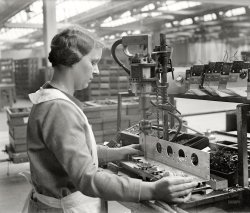
- Patent Office: 1920
- ... The recent renovations included covering over the interior courtyard into a fantastic covered atrium . Visible on the right of ... Posted by Dave - 08/07/2012 - 2:01am -
![Patent Office: 1920 The U.S. Patent and Trademark Office in Washington circa 1920. Which, after a zillion-dollar makeover, is now the Smithsonian's National Portrait Gallery and Museum of American Art. National Photo Co. glass negative. View full size.
They have the patent on tilted lawnsCan anyone explain why that one section of the yard is inclined? Is there some sort of room under it?
[A good question. There were a number of roof and basement skylights covered over after the building was electrified. Or it could have been a driveway ramp. - Dave]
Dancing with the LincolnsLincoln's second inaugural ball took place in this building, in the gallery on the east side (not visible in this shot). It's a great 19th century public space.
Kogod AtriumAhh... The old Patent Office is one of the great architectural buildings in the district. The recent renovations included covering over the interior courtyard into a fantastic covered atrium. Visible on the right of this photo is the grandest brick edifice in D.C.: the old Pension Bureau, now the National Building Museum. I strongly recommend both sites to any visitors to the area.
Also to the right of the photo is the now razed Barrister Building.
Washington Post, Feb 13, 1910
Office Structure Begun
Foundations for another nine-story office building for Washington are being laid at 635 F street northwest, and within the next week or two the public will be able to obtain a general idea as to how large the structure will be when it is completed. The building will be called the Barrister building, and will be a modern fireproof structure, with a 29-foot frontage and a depth of 120 feet. ...
Smithsonian"Which, after a zillion-dollar makeover, is now Smithsonian's National Portrait Gallery and Museum of American Art."
At least they didn't raze the building to build a parking lot...
The ghosts are cool, and there's a lot of them in this one!
[Probably would have been harder to get a $250 million appropriation for a parking lot. - Dave]
Is that a Horse Drawn Carriage sans horse?Behind the clock on the left, is that a Horse Drawn Carriage without a horse, or is that an automobile that would be considered an antique even in 1920?
I mean, those are solid rim wheels!
[That's a runabout. And I'd imagine the four legs belong to a horse. - Dave]
I'm disoriented!I'm confused about which corner I'm looking at. Where was this photo taken from? There is a ledge of some kind in the lower left corner. Is that a window sill? Is it a roof? Also, at the end of the street heading off to the right there is a huge building that looks kind of like the National Building Museum. And what are the minaret-looking towers off to the left?
What would be great is if there was a way to "tag" DC landscape photos like this one to tell us what else is in the picture. Thanks!
[On the left is Ninth Street heading north; to the right is F Street heading east toward the Pension Office, now the National Building Museum. Click below to zoom. - Dave]
I just can't help myself!Under the tilted lawn is the root cellar where they keep their possum.
(The Gallery, D.C., Natl Photo)](https://www.shorpy.com/files/images/32573u.thumbnail.jpg)
- The Happy Homemaker: 1940
- ... lovely strong fingers all three of them have!
Decor Interior design by Philip DeGuard.
Unmistakable Joy is writ as large on ... Posted by Dave - 12/06/2019 - 12:35pm -
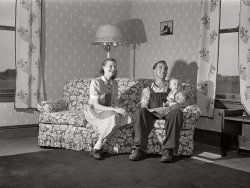
- Sport Fudge: 1924
- Washington, D.C., circa 1924. "Brownley interior." A sort of fernery-confectionery. National Photo Company Collection ... Posted by Dave - 08/11/2011 - 4:06pm -
![Sport Fudge: 1924 Washington, D.C., circa 1924. "Brownley interior." A sort of fernery-confectionery. National Photo Company Collection glass negative. View full size.
Candy CryptIf there was a concession stand at Forest Lawn, this would be it.
Yum!Calories at 5000 per square foot. You could gain weight just walkin' through this place. What's the address?
Sweet ShopWhat a lovely Victorian looking confectionery! So very elegant, clean and welcoming. Mind if I take a seat and sample some sweets?
Ant ProtectionNotice the white pots holding the legs of the cases and tables. I assume this is for keeping the ants away.
A confection outside too!1309 F Street NW. A history of the Brownley Confectionery Building.
[That building was constructed in 1932 -- eight years after this photo was taken. The address of the confectionery in our photo is 1203 G Street NW. - Dave]
Scary sweetsBuying candy in a funeral parol, I don't think so!
Flood ProtectionThe white bootees on the table and counter legs are probably there to protect the wood finishes from regular wet mopping of that American Olean mosaic tile floor. Many years ago I lived overseas in a wet-mopping zone, and none of the household furniture I saw in anyone's houses had any finish left on the first three or four inches closest to the floors.
Buns?Is it possible to get a clearer scan of the sign in the right foreground? It seems to mention "French [something] Buns" at 80 cents a pound. That would amount to $10 or so in today's money.
[FRENCH BON BONS 10¢ LB - Dave]
(The Gallery, D.C., Natl Photo, Stores & Markets)](https://www.shorpy.com/files/images/31639u.thumbnail.jpg)
- The Fight: 1913
- ... the NYC Landmarks Preservation Commission declared the interior and exterior an official landmark in 1987. Now restored to its ... Posted by Dave - 03/09/2015 - 1:42pm -
![The Fight: 1913 New York, 1913. "Quality Shop and Hudson Theatre." Where the audience for Bayard Veiller's drama The Fight included a grand jury probing charges that the play was "indecent and a public nuisance." 8x10 glass negative. View full size.
The alphabet thiefis in town - see usiness en's unch.
I certainly hopethat those two usiness en enjoy their unch at Café Signage.
Business Men's LunchThree martinis and some pretzels.
Quality Replacement Letters could probably be purchased at the aptly named, and handily located, shop a mere two doors down.
[The letters are not actually missing, they're just semi-invisible thanks to the emulsions used in the days before panchromatic film. - Dave]
Red BMLI would surmise, as letters painted with that color would show up darker when using orthochromatic emulsion (no guess as to Pantone color shade though.)
Hudson Theatre is still thereIt's still in business at 141 W. 44th Street. After serving as a movie theater, studio for CBS and NBC, a legitimate theater, a porno house and finally a rock night club, the NYC Landmarks Preservation Commission declared the interior and exterior an official landmark in 1987. Now restored to its original 1903 appearance, the Hudson is part of the Millennium Broadway Hotel next door, and is used as a conference center and venue for special events.
Leo. Feist, Inc.Above the theater is one of the offices of Leo. Feist, Inc., as shown on the open windows and also by the large brass plate on the corner of the building. Leopold Feist founded and ran a music publishing firm in the early 1900s. By the 1920's, Feist was among the seven largest publishers of sheet music in the world. He had offices in major cities around he globe. His largest selling piece of sheet music was "My Blue Heaven" published in 1927. Emblazoned -- at least once on every music sheet he published -- was the slogan "You Can't Go Wrong With Any Feist Song". After his death in 1930, most of the Feist music catalog was acquired by MGM.
ComstockeryAccording to John Houchin's "Censorship of the American Theatre in the Twentieth Century", many early twentieth-century plays dramatized female sexual abuse (fueled by a moral panic over "white slavery"). What the authorities took exception to in "The Fight" was a confrontation set in a bordello, where the heroine (campaigning for public office) accuses her opponents of corrupting young women and the community for their own profit. In anticipation of the grand jury's visit, Veiller rewrote the second act and merely described the bordello scene, instead of showing it onstage, and after viewing the revised version, the grand jury dropped all charges.
(The Gallery, NYC, Stores & Markets)](https://www.shorpy.com/files/images/SHORPY-4a22195a.thumbnail.jpg)
- Expecting: 1920
- ... in those days.
Strictly germ-proof this bare white interior reminds me of the old poem:
Strictly Germ-proof
THE ... Posted by Dave - 08/09/2012 - 11:06pm -
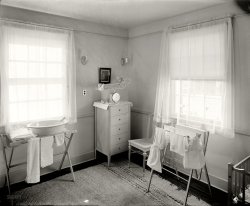
- Loves Olives: 1956
- ... everywhere at the time: car paint, fiberglass boats, interior décor, furniture, home exteriors, advertising layouts, product ... Posted by Dave - 06/14/2012 - 4:59pm -
![Loves Olives: 1956 Southern California circa 1956. One of a dozen Kodachrome slides that I recently found on eBay. If the clothes here were any sharper we'd need to call 911. No T- shirts and jeans for these folks. More to come over the weekend. View full size.
Pink Golden AgeIf this photo was shot in 2012, the young woman's clothing would be far different. The Pink Top would be gone and the Dress would be daringly unbuttoned.
It's been interesting watching Shorpy Photos and seeing the progression of women wearing less and less clothing through the years since the camera was invented. Seems the 1950s was the happy medium.
What were we thinking?I’m guessing the guy on the left is wearing suede shoes. 1955/56 were the years of pink and charcoal attire for men of the world, as were blue suede wingtip shoes. What we can see of him measures up to the standard, so I’m assuming his footwear does also---including the obligatory pink argyle socks. Pastel colors abounded everywhere at the time: car paint, fiberglass boats, interior décor, furniture, home exteriors, advertising layouts, product packages, etc. Thankfully, providence spared us the simultaneous affliction of women’s sack dresses during the same period, as they were still a couple of years off.
"Mad Men," eat your hearts out!Why does the song "Sharp Dressed Man" come to mind? Seriously, the clothes are wonderful!
Green olive loverThat's a really cute girl! I'm wondering what the story is about the b&w photo of the white couple. Maybe Olive Girl is biracial and those are her grandparents. I'm speaking this as a mother with two biracial kids and three biracial grandkids, as of yesterday (baby boy, 7lbs 6oz)!
UnforgettableHaving been a fan of Nat King Cole, I attended some of his concerts in the early '60s. He dressed so very similar to these two men, very elegant, slender, meticulously groomed and a very smoooooth operator. As soon as I saw this picture, I was reminded of his demeanor. He was especially graceful and attentive to his fans and yet was so humble and congenial to all and his voice was one in a trillion, never to be duplicated. Even though these two do not really look alike, they both interpreted his sophisticated "style" beautifully.
What my sons would say"If you could get ALL those olives in the dish into your mouth at the same time, I'll give you a quarter." This was the kind of stunts they'd pull in their teen years and beyond. Their youngest brother at age 5 had a near tragedy trying to fit a whole wedge of cantaloupe in his mouth at once. Thank goodness Mom intervened.
Great Photo findThere are still many of us around from that age and that time. Dave, I hope you can get some names to attach to the pictures. I'm looking forward to the next of the set.
[Alas, the only name on these slides is "Kodachrome." -Dave]
B&W PhotoI don't think the couple in the photo are white noelani. I think the woman is just lighter skinned.
(SoCal 1956 Kodachromes)](https://www.shorpy.com/files/images/SHORPY_Olive_Party.thumbnail.jpg)























